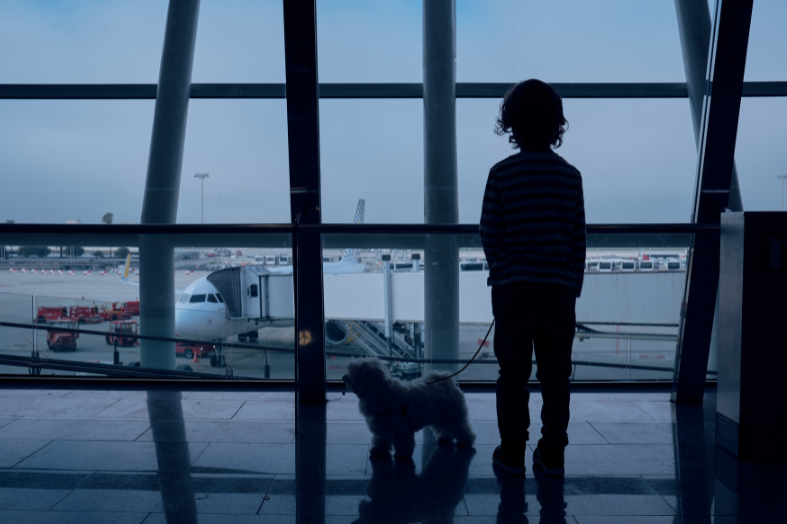Each year, two million jet-setting pets hit the skies.
And while traveling with our pets can be fun, it takes thorough planning and consideration.
Last week, we published a guide for taking road trips with pets.
Today, we’ll explore how to safely fly with pets, so they never miss out on family vacations.
What to Do Before Flying
1. Research Airline Criteria
Each airline has different criteria for flying with pets. We should research our airline’s requirements, and call them to ask:
- Can pets travel to our target destination?
- Are pets allowed to travel in the cabin? Typically, small cats and dogs (and sometimes other animals) whose carriers can fit under the seat are allowed. If yes, we should let the airline know we’ll be traveling with a pet in the cabin, as they often only allow a limited number of pets.
- Is there a charge for flying with pets?
- What items do we need to bring?
- If pets have to fly as cargo, are the cargo holds temperature-controlled and ventilated?
- Are there restrictions on flying days due to temperature?
- What type of carrier (cabin) or kennel (cargo) is needed?
- What documents are required?
- For dogs, are there breed restrictions?
- What’s the check-in procedure?
- How long will pets be left on the tarmac?
- Can we see our pets during layovers, and are there designated spaces for potty breaks?
- For cargo travel, where do we pick up our pet on arrival?
2. Get Vet Clearance
Our pet’s health should be our number one priority. Plus, many airlines require a recent health certificate signed by an authorized vet.
We should make sure our pets are generally healthy, and up to date on vaccinations (incl travel-specific ones).
It’s important that we bring copies of our pet’s health records.
3. Acclimate Pets to Their Travel Carrier
Flying can be stressful for our pets. Helping them get used to their travel kennel before the trip can help reduce stress.
Like at-home crate training, the goal is for them to view the crate as a safe, comfortable place.
- Start at least three weeks before traveling. The earlier, the better.
- Use a step-by-step familiarization process:
- Week 1: We can feed our pet meals in the carrier, with the door open.
- Week 2: Give meals in the carrier with the door closed. Open when they are done (or after 15 minutes).
- Week 3: We can have our pet go into the carrier 15 minutes before mealtime, and then repeat the week 2 steps.
- Reward pets with praise (or a fun activity) after they spend time in the carrier. This will help them associate it with positive feelings.
- Line the carrier with a familiar item, like a thin dog bed, blanket, or t-shirt.
- Take pets for test rides in the carrier. We can go to noisy places with new sounds and smells. This will help prepare our pet for the airport.
4. Make Sure ID Tags are Up to Date
We should make sure our pet’s ID tags are current and in good condition. In addition, we should attach a travel ID tag to their collar. It should include the contact details for our travel destination. Otherwise, it can include contact information for emergency contact.
If our pet goes missing, we can be contacted easily.
We should also put a travel tag on their carrier with the same information.
5. Don’t Feed Pets Before a Flight
We shouldn’t feed our pets immediately before, or during, travel. Stop feeding pets 2-3 hours before the flight.
Pets must remain in their carrier or kennel during the flight; their stomachs should be empty to reduce the chances of a bowel movement. This can be messy and cause pets discomfort.
However, giving pets water is recommended for flights longer than 4 hours.
6. Don’t Sedate Pets
It’s commonly believed that giving our pets a tranquilizer before traveling is helpful for them. However, it can actually lead to health complications and injury.
Firstly, not enough is known about the impact of sedation and changes in air pressure on pets. Also, these drugs suppress our pet’s lung and heart functions, which may cause complications.
Sedating drugs may also have unpredictable effects on each pet. For example, cats may become more stimulated rather than calm.
Lastly, they make it difficult for our pets to control their balance. In a moving vehicle, balance is critical for helping our pets stabilize and brace themselves. Inability to do this can lead to injury.
7. Take Direct Flights When Possible
If we plan on putting our pet in the cargo hold, we should try to take a direct flight. This will eliminate loading/unloading delays for our pets, thus lessening the chance they’ll get lost in transit.
8. International Travel with Pets
Each country has different requirements for traveling with pets. For example, some countries may require dogs to be quarantined, or have temporary bans on all pets from high-risk rabies countries.
It’s important that we check the specifications of our destination country.
Some common requirements are:
- An updated microchip (usually International Organization for Standardization compliant)
- Up-to-date rabies vaccinations
- Government export papers
- Health certificate signed by a vet who’s endorsed by the USDA
- Declaration of Non-Commercial Transport Form
Some countries require additional documents, like proof of recent rabies and tapeworm test. The USDA Animal and Plant Health Inspection Service has an excellent database to search pet travel requirements for other countries.
Summary
Traveling with our pets can be a rewarding experience full of fun memories. But before the fun begins, we need to plan carefully. This is especially true for flying with pets. Being prepared will help us reduce stress on ourselves and our pets, so we can have a worry-free vacation.
Sources:
https://www.pettravel.com/news_pet_passport.cfm
https://www.starwoodanimaltransport.com/blog/5-tips-to-acclimating-your-pet-to-his-crate
https://www.petrelocation.com/blog/post/should-pets-be-sedated-during-air-travel
https://www.washingtonpost.com/travel/tips/questions-about-flying-with-your-pet-us-answered/
https://longhaultrekkers.com/flying-with-a-large-dog-in-cargo/

